

Damion Smy
GWM Cannon Alpha ute, Tank 300 HEV and Tank 500 recalled
1 Day Ago
The Kona N impresses with its playful dynamics and smile-inducing performance. If you want a fast SUV, there's not much like it for $50k.



Marketplace Editor
New from
$47,500
excl. on-roads

Marketplace Editor
New from
$47,500
excl. on-roads


Marketplace Editor
New from
$47,500
excl. on-roads

Marketplace Editor
New from
$47,500
excl. on-roads
Quickly see how this car stacks up against its competition. Select any benchmark to see more details.
Where expert car reviews meet expert car buying – CarExpert gives you trusted advice, personalised service and real savings on your next new car.
Hyundai’s N Division is branching out beyond the world of traditional hot hatches and sedans.
First came the i30 N, Veloster N and i20 N hatchbacks, with the Elantra (i30 Sedan N) also on the way. Now, it’s adding an SUV to the mix, in the form of the 2022 Hyundai Kona N.
Based on the Korean brand’s popular compact crossover, the hottest Kona shoehorns the i30 N drivetrain into its SUV body, promising the same go-fast N appeal with the higher-riding, seemingly more practical packaging of a Kona.

Arriving in Australia with no real competition (given the Volkswagen T-Roc R is still some months away from our shores) the Kona N answers a question that no one has really been asking… yet.
While mainstream-branded performance SUVs aren’t really a thing, premium brands have been doing it for a while. So think of the Kona N as a cut-price alternative to the likes of the Audi SQ2, BMW X2 M35i, and Mercedes-AMG GLA35.
Despite only offering front-wheel drive and not AWD like the bulk of conceptually-similar offerings, the Kona N has more than enough performance on tap – and the lighter front-drive layout makes for some good fun on road and on track.
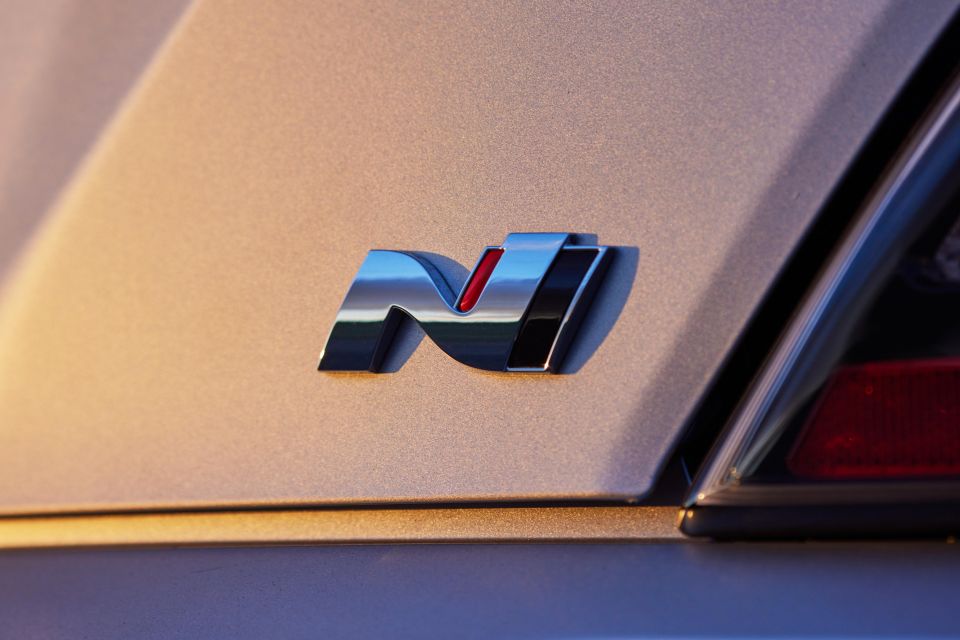
Two variants of the Kona N are available in Australia. Both are auto-only, and both come pretty loaded with kit.
2022 Hyundai Kona N pricing:
Prices exclude on-road costs.
The standard Kona N is just $5000 dearer than the Kona N Line Premium, which offers decent punch (146kW/265Nm) from its smaller 1.6-litre turbo as well as all-wheel drive traction, but is nowhere near as ferocious as the full-fat N.
As noted earlier, the Volkswagen T-Roc R is due around July 2022, and will be a little wilder with its more powerful 221kW/400Nm 2.0-litre turbo four and all-wheel drive. It’ll likely be closer to the $60,000 mark when it lands, too.
The Audi SQ2 – which essentially runs the same drivetrain as the T-Roc – starts at $64,400 before on-road costs and is arguably the Kona N’s most natural rival in terms of size and performance, though again it’s all-wheel drive, more expensive, and wears a premium badge on the nose.
So as it stands, the Kona N has no real competition unless you consider the likes of its i30 N stablemate and its litany of rivals including the Ford Focus ST, Renault Megane RS and Volkswagen Golf GTI.

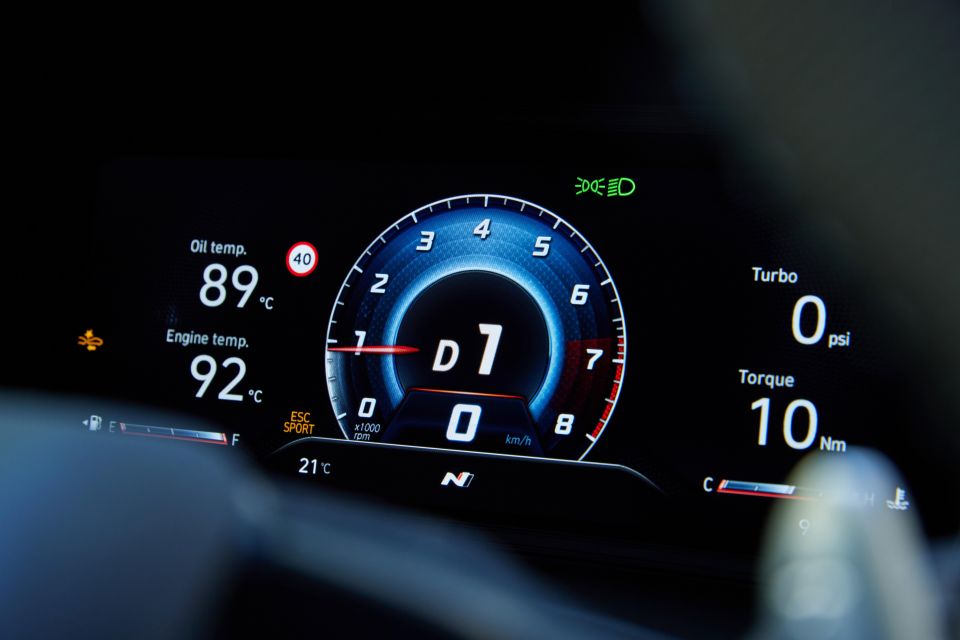


Buy your new car without the stress. It's fast, simple and completely free.

Great service from Travis and team, second time I have used this business would not hesitate to recommend them to anyone
Craig C.
Purchased a Ford Ranger in Sunshine Coast, QLD
CarExpert helped Craig save thousands on his Ford Ranger, now let us save you on your next new car.
Find a dealKona N highlights:
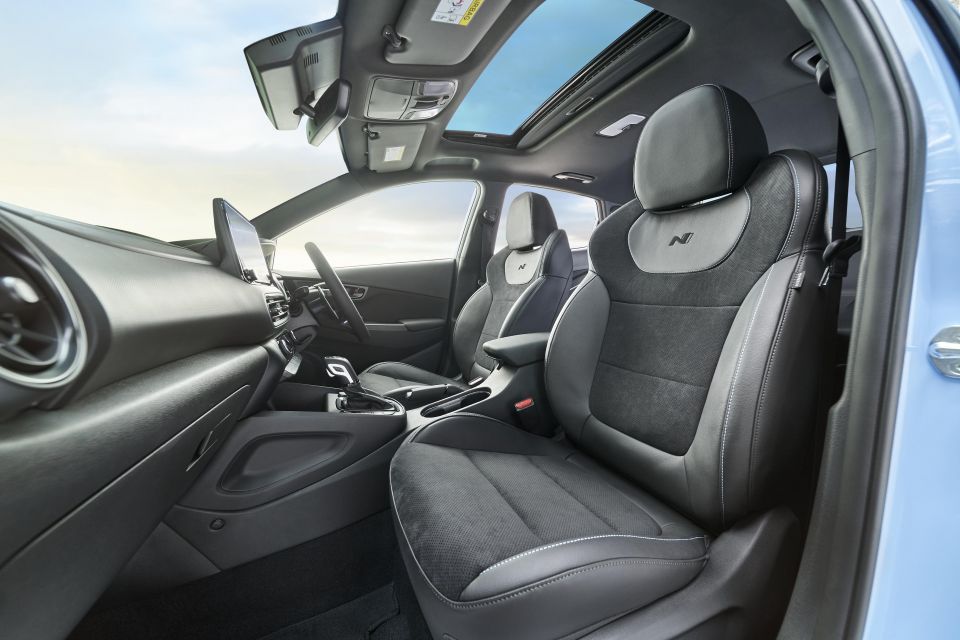
Kona N Premium adds:
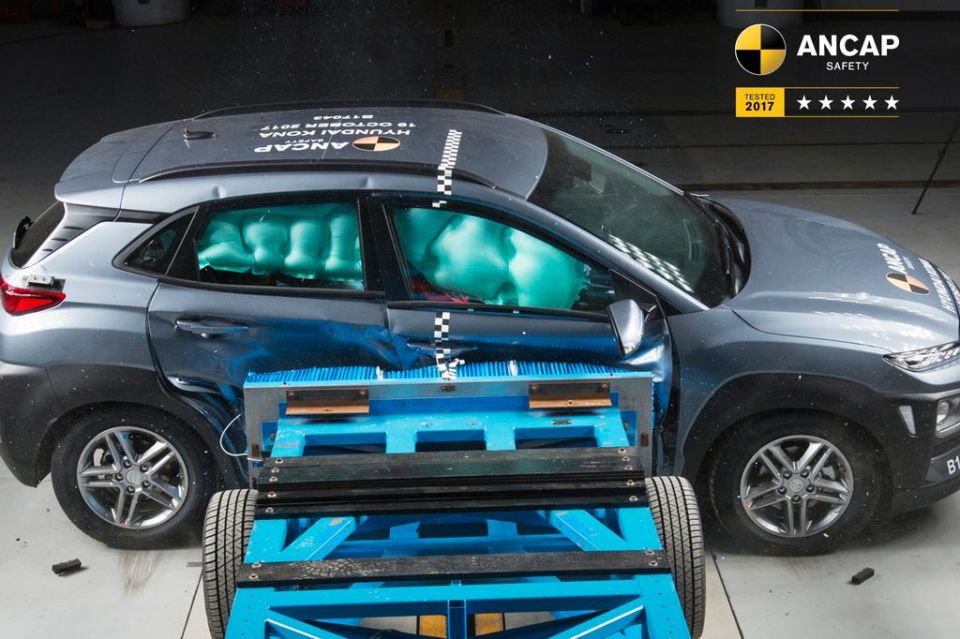
While the core Hyundai Kona range (including the Kona Electric) wears a five-star ANCAP safety rating based on 2017 testing, Kona N models remain unrated by ANCAP and Euro NCAP at this stage.
That rating was based on a frontal offset score of 14.07 out of 16 and a side impact score of 16 out of 16. Whiplash and pedestrian protection were rated Good and Acceptable, respectively.
Standard safety equipment includes:
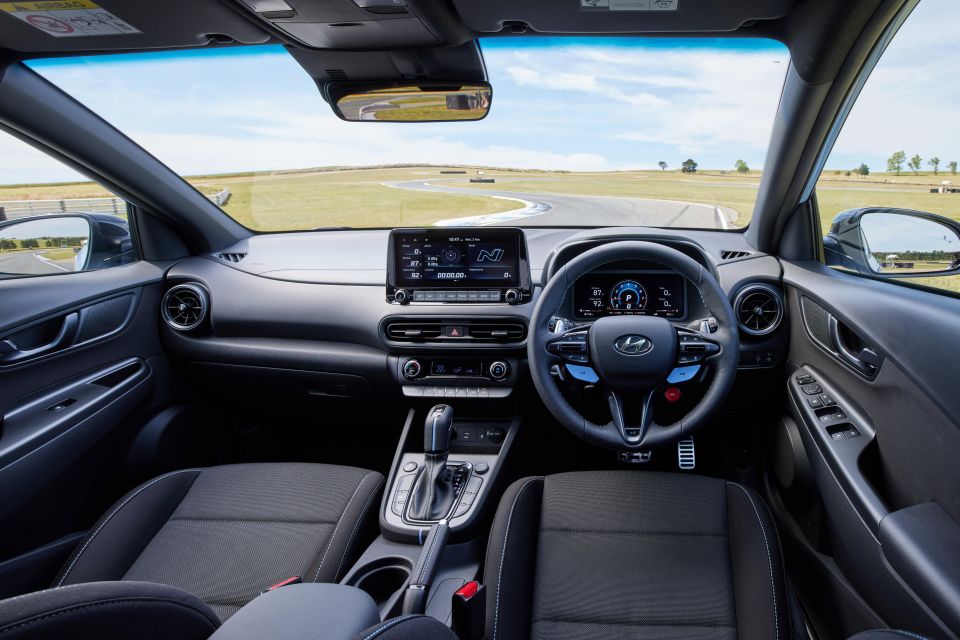
Very much like a Kona, but a little bit better.
While the overall fit and finish remains the same as the regular Kona range – decent build quality, with some cheap-feeling plastics dotted about the place – the N bits such as the steering wheel, N sports seats, and racy performance displays specific to the go-fast variant dress it up enough.
Comfort from the sports seats is very good, and the raised driving position gives you a commanding view of the road ahead. The perforated leather steering wheel feels first-class in the hand and both the driver’s seat and steering wheel offer a good range of adjustment to allow taller drivers like myself (6’1) to fit with a helmet.
Other than a soft-touch insert in the dashboard, the bulk of the cabin’s surfaces are hard plastic, which doesn’t scream high-end for a compact crossover costing at least $50,000 on the road. The i30 feels a bit more upmarket in this regard.
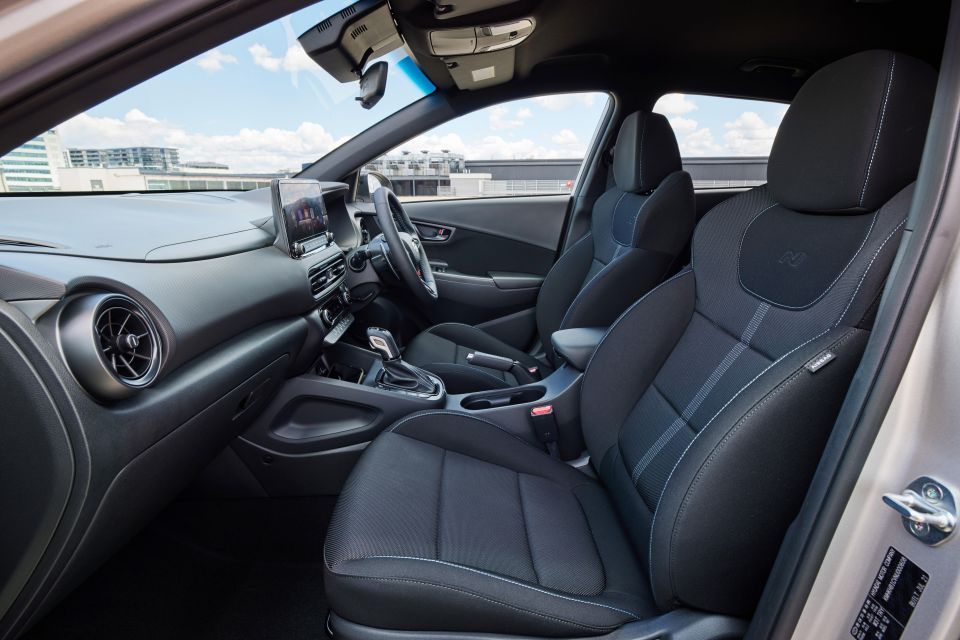


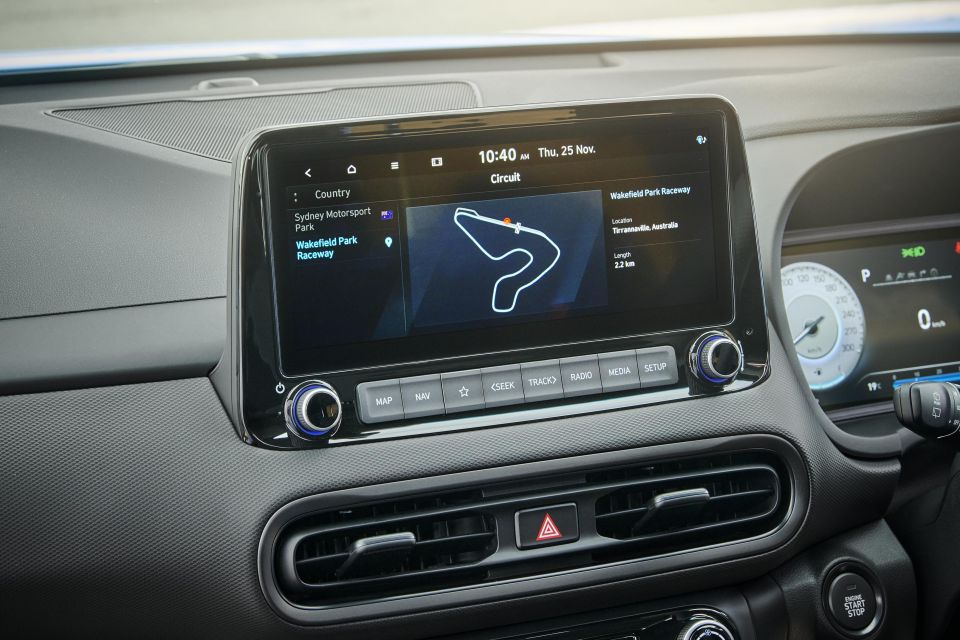
The displays are ace. The dual 10.25-inch screens for the instrument cluster and infotainment offer high resolution, snappy response times, and cool graphics. I really like the dedicated N layout for the instrument cluster, along with the N performance displays with Track Maps in the infotainment.
Just like in the i30 N, the Kona N allows you to customise an array of elements with its Custom modes, accessible via the touchscreen. Everything from engine and transmission calibration, to suspension, exhaust sound and differential can be adjusted through two or three different settings.
While there isn’t a manual option for purists, there’s a proper manual handbrake wrapped in leather with contrast Performance Blue stitching, as well as meaty paddle shifters behind the sports steering wheel. Both feel great in the hand and the latter are quite good when driving hard – more on that later.
The standard Kona N’s cabin feels good enough, but you can opt for the Kona N Premium and upgrade to a colour head-up display, heated/ventilated front seats trimmed in leather/suede, and a powered sunroof – which I know is important to a lot of buyers, even if I can live without one on a car made for track use.
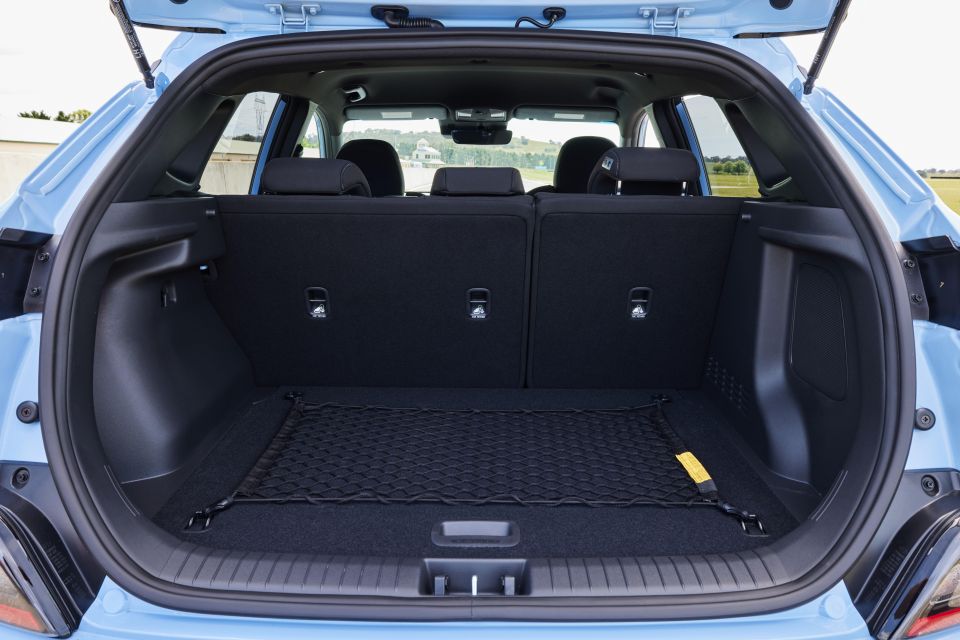

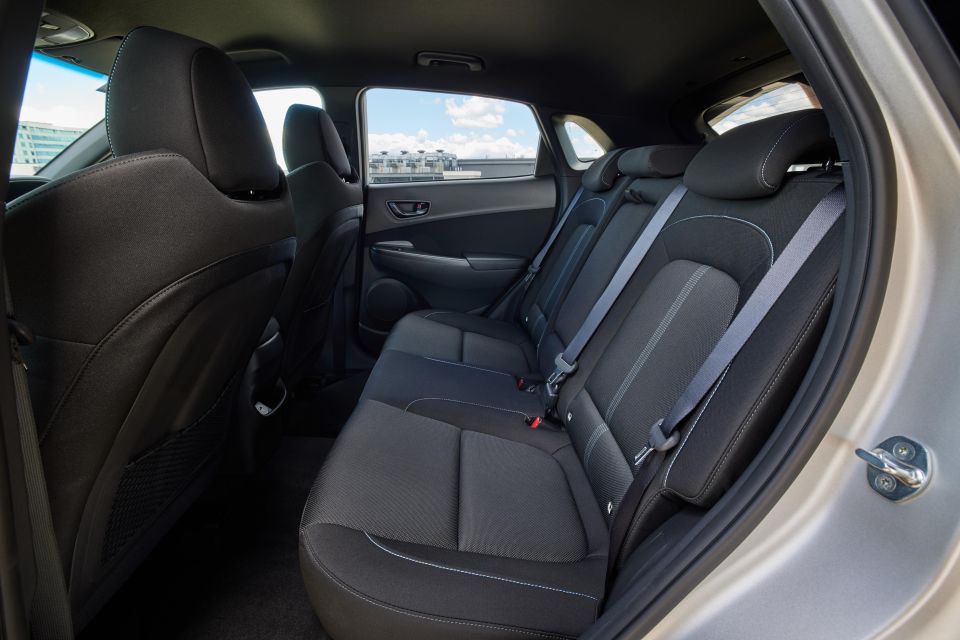
The second row is a little tight for space if you’re a taller adult. I am a bit squished behind my own driving position, so if you have adult-sized kids you may want to look at the i30 N hatch or even wait for the bigger i30 Sedan N.
The Kona N is also less practical than its i30 N stablemates when it comes to boot space, despite being billed as a more practical SUV.
Offering 361L with the rear seats in place and 1143L with them folded, the Kona N is down 20L and 144L respectively on the i30 N hatchback. What you do gain is ground clearance, which at 173mm (+37mm compared to i30 N) means getting in and out of steep driveways should be a little easier on the front lip.
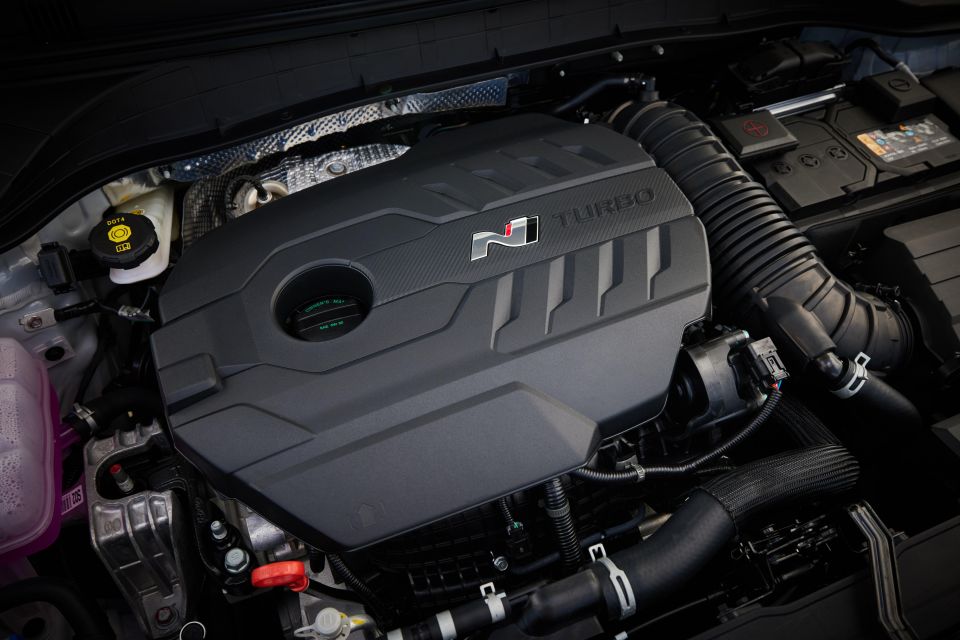
The Kona N is powered by the same 2.0-litre four-cylinder turbo petrol as its i30 N stablemate, producing 206kW (5500-6000rpm) of power and 392Nm (2100-4700rpm) of torque.
Interestingly, despite being a crossover, the Kona is exclusively front-wheel drive and is also only available with Hyundai’s new eight-speed wet-type dual-clutch automatic transmission.
There’s an electronically-controlled mechanical limited-slip differential on the front axle to help get the power down, which offers both Normal and Sport settings.
Hyundai claims the Kona N will dash from 0-100 in just 5.5 seconds, on its way to a top speed of 240km/h. Further, the brand says the hot crossover will accelerate from 80-120km/h in 3.5 seconds.
The Kona N quotes combined fuel consumption of 9.0L/100km, with 95 RON premium unleaded required as a minimum for its 50L fuel tank. Unlike the smaller i20 N, the Kona N doesn’t feature idle stop/start technology.

We drove the Kona N and i20 N back-to-back between Sydney and Goulburn during the road drive, and then on Wakefield Park Raceway.
It was quite interesting to feel the distinct personalities of the two vehicles on road and on track.
Where the i20 N is quite raw and gives you a very direct connection to all aspects of the driving experience just about all of the time, the Kona is a little more adjustable and has the split personality that we’ve come to expect from higher-end European performance products.
The adjustable damping is a godsend on lumpy B-roads and rough country highways, and the Kona’s seats are supremely comfortable on road and track, but also hug you tight.
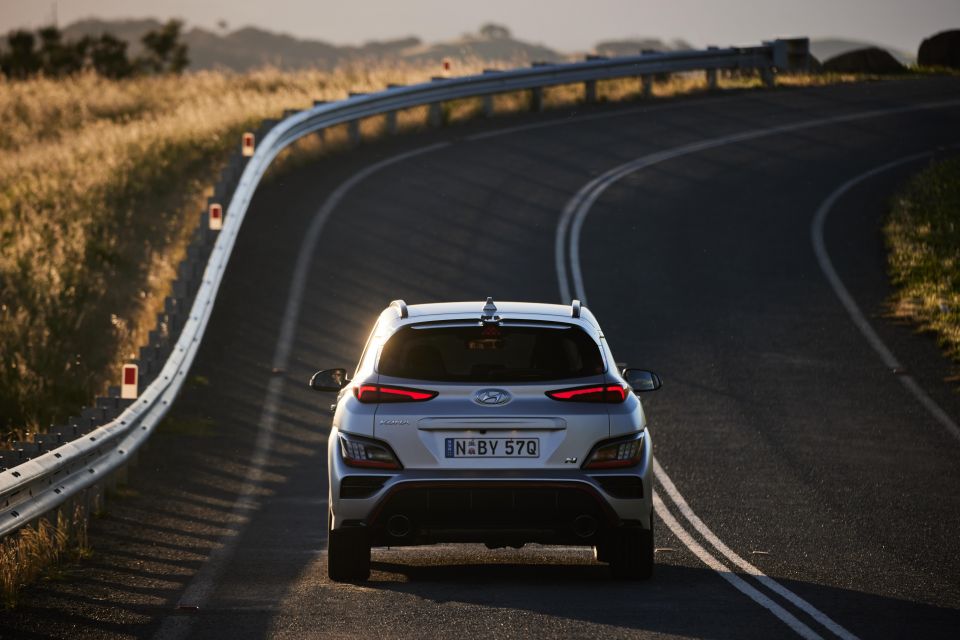
On the road the Kona demonstrated great breadth of ability and proved itself to be a pretty decent grand tourer.
The power from the 2.0-litre turbo and angry bark from the variable exhaust make it feel like a much more substantial vehicle than its compact dimensions would suggest, and the extra height and travel in the suspension make it quite a playful thing to chuck around.
Something that really stood out to me during this drive was Hyundai’s new eight-speed wet-type DCT. I hadn’t driven one of the new N products with it until this launch and wow, it’s excellent.
Being a Golf GTI owner myself – specifically one with a DSG – I was very impressed with Hyundai’s calibration of the DCT in this N application. It’s fast, seamless, and smart.
There’s no jerky, hesitant feeling off the line, and it’ll rifle through the cogs like it ain’t even trying.
It’s so quick that Hyundai has even engineered an N Grin Shift mode that boosts power slightly for about 20 seconds, and also adds some drama and theatre by forcing some recoil through the driveline with each shift. For me, I just enjoyed changing up so quickly and getting pops and cracks with each pull of the paddles.
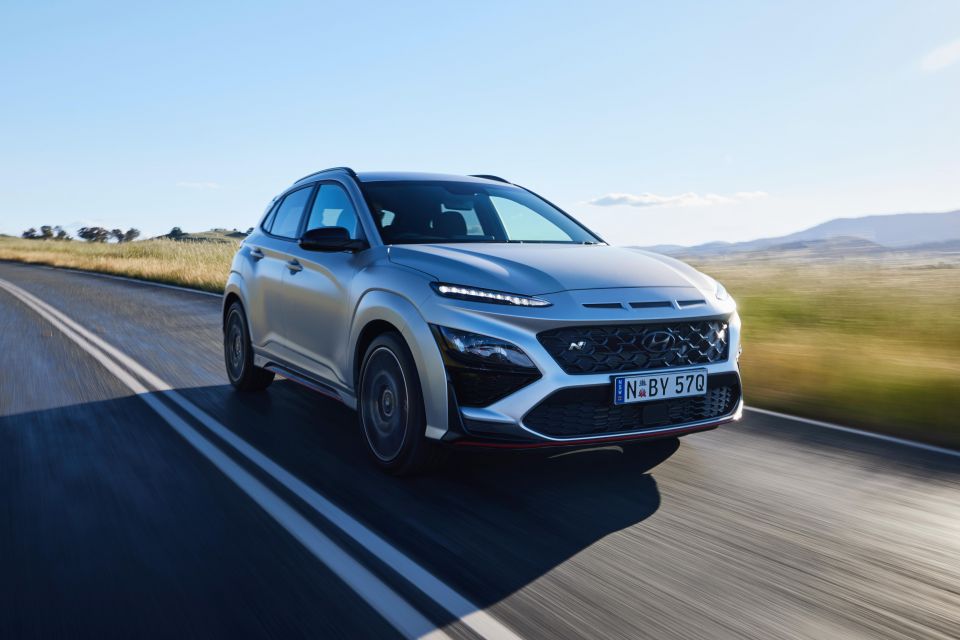
Speaking of ‘quick’, the vehicle itself is bloody fast. Being a front-drive high-performance vehicle, it’s never going to have a 0-100 claim to match AWD rivals, but the acceleration in the little Kona is brutal.
Point it where you want and plant your right foot and the Kona N rockets towards its target with almost terrifying pace. Add that distinctive N soundtrack and you’ve got a little SUV that can actually put a smile on your face.
The only real complaint I had on the road was the road noise over coarse-chip bitumen, which made up the bulk of the drive route. Like the standard Kona, there is a bit of tyre roar that gets into the cabin, and it echoes around.
Hot tip, fire up that standard Harman Kardon eight-speaker audio system and pump the tunes when on long roadtrips to drown out the racket from those Pirelli P-Zero performance tyres.
Grip was plentiful even with some mixed weather conditions and poorly-surfaced roads. The Kona N may wrestle you a little if you go foot to the floor but through tight bends and wet weather it never felt nervous or sketchy.
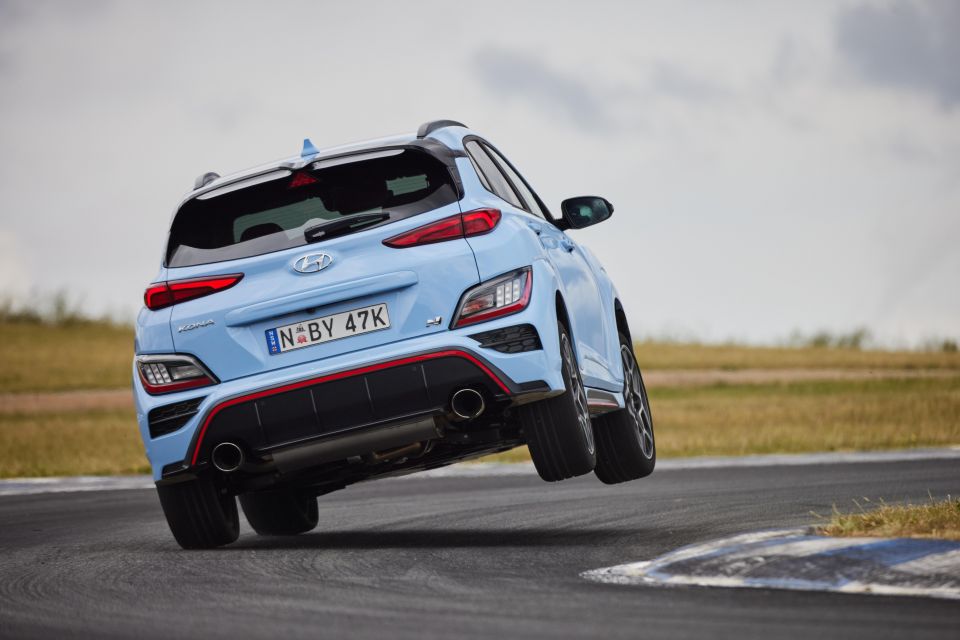
Where expert car reviews meet expert car buying – CarExpert gives you trusted advice, personalised service and real savings on your next new car.
Now, the circuit.
The Kona N wouldn’t be my first pick for a track day, but it’s still a lot of fun. Where the i20 N feels like a scalpel, the Kona N feels more like a mallet, but in a good way.
It’s a bruiser for the straights, picking up so much speed you’d be surprised (I saw nearly 180km/h on the main straight at Wakefield), and it feels almost silly to be sitting so high on track.
Even in its firmest suspension setting there’s a bit of body roll but not to the point of being wallowy or unresolved. Think of it more like a Mazda MX-5 level of lean.
The Kona’s electronically-controlled mechanical front differential does an admirable job of getting the power down out of corners as well as minimising understeer and torque steer, but carry too much speed and you’ll wash wide.
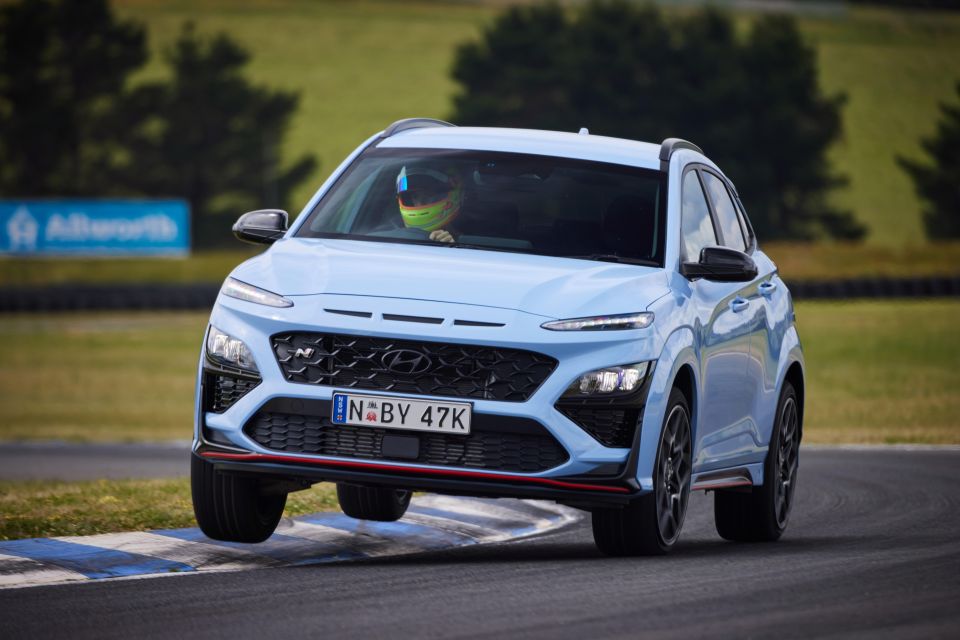
But the rolly body and playful dynamics make the Kona N a stack of fun to drive on track, and if you get really comfortable with it you can get lift-off oversteer. I just wouldn’t be chasing lap times in it.
Like with the i20 N, I got a stint in the passenger seat with rally driver Brendan Reeves at the wheel. It was one of the first times he had driven the Kona N when I rode shotgun, so getting his initial impressions while flying around Wakefield Park was an awesome experience.
It’s always cool to ride with a professional driver to see what a car is really capable of, and the Kona’s playful character really came through in Brendo’s hot laps as well. It bobbed and leaned and slid around, and then with some straight blacktop it just shot itself towards the horizon.
The whole thing just felt silly, but in the best way possible, and the Kona didn’t feel like it was every really out of its depth – but you have to really get to know it before having a proper crack at a technical track like Wakefield.
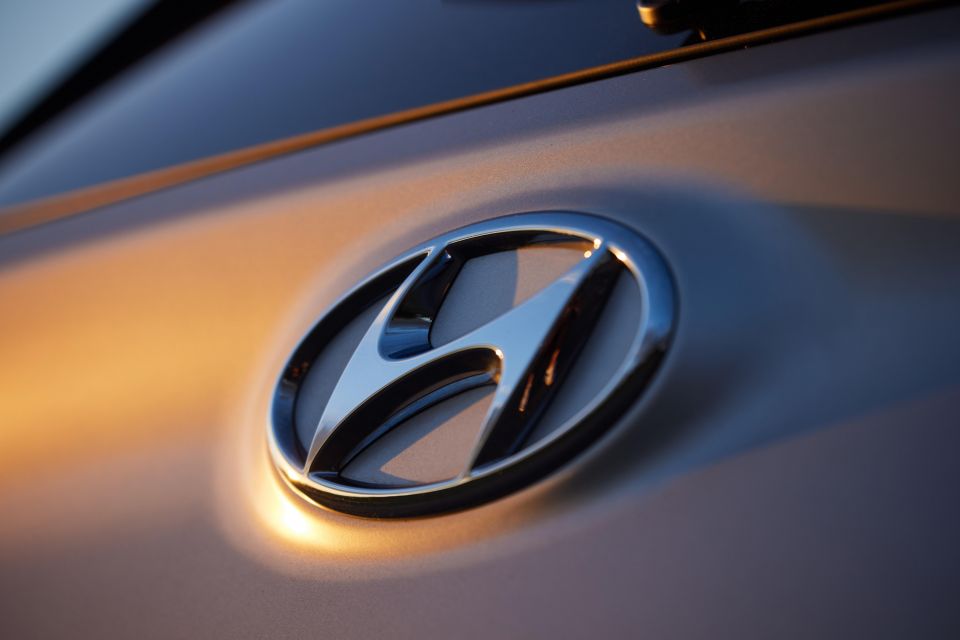
The 2022 Hyundai Kona N is covered by a five-year, unlimited-kilometre warranty.
Servicing is required every 12 months or 10,000km, whichever comes first, and the first five services are capped at $335 each.
Real-world fuel consumption is best left for a proper road test, but during the road drive with spirited country driving and extended freeway stints we saw the indicated readout sitting in the eights and nines, in line with the company’s 9.0L/100km combined claim.
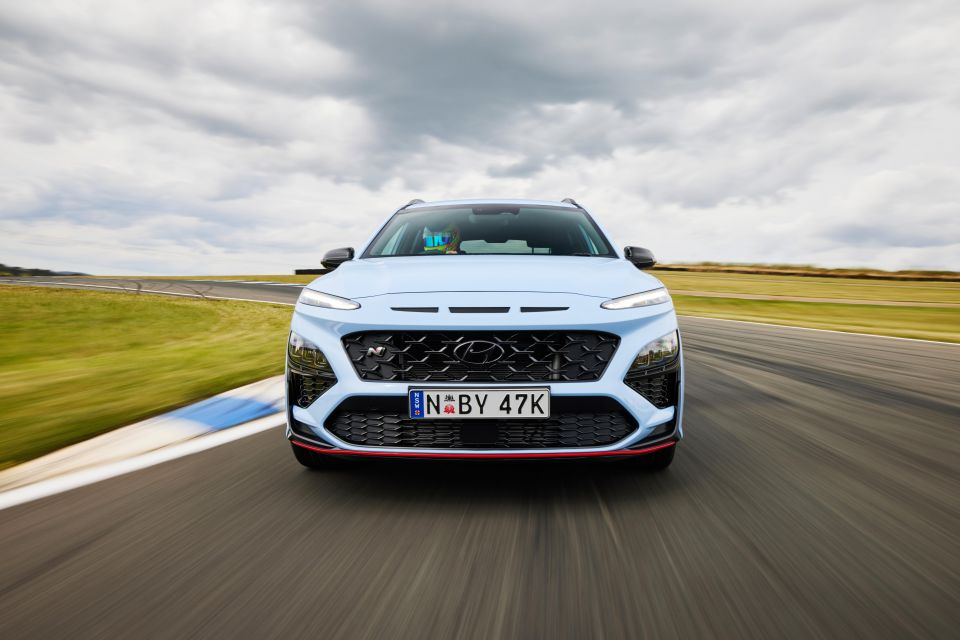
I’m usually averse to performance SUVs because they tend to be fairly compromised and lack soul. The Hyundai Kona N really changes that narrative.
Everything I love about the i30 N – the performance, the sound, fun-to-drive character – is here in the Kona. But it looks funkier, will appeal to those who want an SUV, and gets some unique features like the digital instrument cluster that the hatchback just doesn’t offer.
Plus, being sourced from Korea it’s actually slightly cheaper than the equivalent i30 Hatch N DCT spec-for-spec.
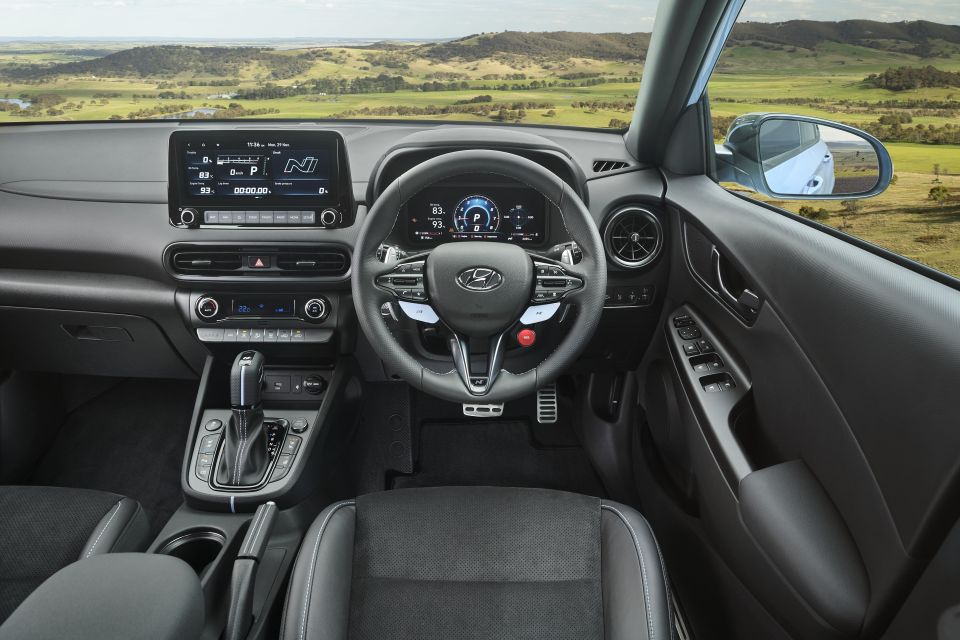
With that said, it’s not as sharp as its hatchback sibling, and despite being billed as an ‘SUV’ it’s not as practical in terms of passenger space or luggage volume as said hatchback sibling. Some may also associate SUV with AWD, which the Kona N doesn’t have.
But that’s not really the point. Many will just want the fun and performance of the i30 N in a Kona body – and that’s exactly what this is.
The Kona N proves that a performance SUV doesn’t have to be stale compared to its passenger car equivalent, and offers a balance of performance, features and value that’s unrivalled at this end of the market. I expect to see plenty on the road very soon.

Click the images for the full gallery
MORE: Everything Hyundai Kona
Where expert car reviews meet expert car buying – CarExpert gives you trusted advice, personalised service and real savings on your next new car.
James Wong is an automotive journalist and former PR consultant, recognised among Australia’s most prolific motoring writers.


Damion Smy
1 Day Ago


William Stopford
1 Day Ago


Matt Campbell
2 Days Ago


William Stopford
2 Days Ago


CarExpert.com.au
5 Days Ago


Damion Smy
6 Days Ago